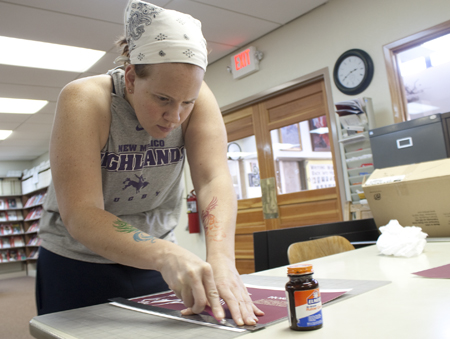Highlands University Media Arts Students Create Navajo Exhibit for Crownpoint 100-Year Celebration
New Mexico Highlands University media arts students created a multi-media exhibit, ‘100 Years of Navajo History: Celebrating Crownpoint,’ which opened April 3 at the Octavia Fellin Public Library in Gallup, N.M.
The students designed the exhibit for the Crownpoint Historical and Cultural Heritage Council. It is the first museum-quality exhibit to feature Crownpoint, which is located in northwestern New Mexico in the eastern agency of the Navajo Nation. Crownpoint celebrates its 100-year anniversary this summer.
The undergraduate and graduate students created the exhibit this semester in media arts professor Andrew Wollner’s Exhibit Design class. The project is funded through a grant from the New Mexico Department of Cultural Affairs.
“With this exhibit, I think the Highlands Media Arts Program is making a major contribution to preserving our Navajo history and culture for future generations,” said Leonard Perry, president of the Crownpoint Historical and Cultural Heritage Council. “We gave the students freedom to be creative in putting the exhibit together, and we are more than pleased with the result. They did a really good job and we appreciate their hard work.”
Library namesake Octavia Fellin attended the opening for the exhibit, and said it is visually the most professional exhibit ever displayed at the library.
The exhibit includes three vignettes. One depicts the sacred role horses play in Navajo culture; one honors Navajo veterans; and one highlights weaving in Navajo life, with a focus on the Crownpoint Rug Auction.
Navajo creation stories and illustrations are integral to the exhibit. The horse, eagle, sheep and coyote stories are included.
“My students approached this design project with a great deal of cultural sensitivity in hopes that we can accurately tell the Navajo story with material provided by cultural historians,” Wollner said. “The students’ early designs were critiqued, and the quality and caliber of their final designs are on par with professional designers working in the creative industry.”
Wollner said he was impressed with his students’ ability to collaborate as a professional team within a strict budget, which fostered creativity.
Media arts senior Devyn Dennison is a Navajo from Tohatchi, N.M., whose work is featured in the exhibit, including a video documentary titled, ‘Indian Rodeo on the Navajo Nation,’ she produced during a 2009 internship with the Crownpoint Historical and Cultural Heritage Council.
Dennison worked on the horse vignette, which uses a multimedia interface with a computer. The installation gives viewers a chance to interact with the digital horse design using a mouse.
“It’s really important to me to try to help preserve Navajo values with this exhibit, especially for youth, to keep our heritage and culture alive,” said Dennison, who is also a member of the university’s rodeo team. “This includes all the sacred things that are part of being Navajo, like the importance of horses. As an Indian cowgirl, the exhibit is very special to me.”
Angelo Mitchell, another senior, worked with the student team that created the exhibit vignette that honors Navajo veterans. It features three poster size digital photo prints, including one of Navajo code talkers serving in World War II. A photo of the legendary Navajo Chief Manuelito, who lived from 1818 to 1893, is also prominent in the vignette. The third piece is a photo collage of a modern-day soldier.
“It takes a lot of research to be culturally sensitive, and to gather the content for creating the images,” Mitchell said. “Our vignette tries to depict the pride Navajo soldiers take in their military service and their historical heritage as warriors. One common theme throughout time is Navajo warriors protecting home and land.”
Mitchell was also a member of the student team that designed the visual branding for the exhibit. He said the team researched museum exhibits to gather ideas about how effective exhibits are designed for flow and continuity.
“Coming up with a concise, cohesive plan to make the exhibit functional, inviting and interactive was a good intellectual challenge,” Mitchell said. “It’s a great learning experience designing work under budget and deadline pressure. This will help me in the real design world.”
Wollner said the centerpiece for the weaving vignette is a full-scale, traditional Navajo weaving loom Bonnie Yazzie donated for the exhibit. Yazzie is another member of the Crownpoint Historical and Cultural Heritage Council, and is a weaving instructor at Navajo Technical College.
Looking ahead, Leonard said that the Highlands’ students work is so professional that he hopes they will produce additional design work for a visitor’s center and museum that is being planned for Crownpoint. He wants to see ‘100 Years of Navajo History: Celebrating Crownpoint’ be one of the inaugural exhibits for the facility.
The Highlands University media arts students who created the exhibit include:
Horse vignette: Devyn Dennison, lead, and Charles Ulibarri
Navajo veteran vignette: Anthony Irions, Kirpal Khalsa, and Angelo Mitchell
Weaving vignette: Kenneth Chombah, Melissa Marquez, and Joe McCaffrey
Navajo creation stories: Rebecca Glenn and Joshua Phillips
Visual branding: Katie DeLion, lead, Devyn Dennison, Melissa Marquez, and Angelo Mitchell
Curator: Adrienne Booth

